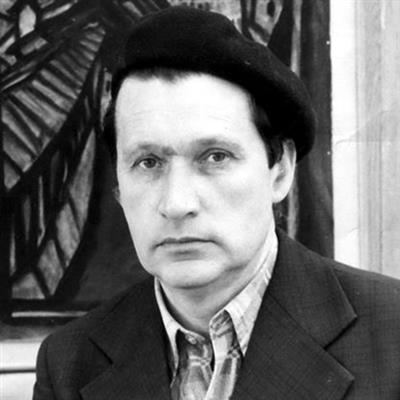Yuriy Khymych

Yuriy Khymych (1928 – 2003) is an outstanding neo-modernist artist, and a classical figure of the Ukrainian visual arts. He worked in the architectural landscape genre.
In late 1950, Yuriy Khymych gained fame among art critics as one of the best watercolorists in the USSR.
Khymych’s works are unique and immediately recognizable. He does not simply record architectural artifacts in their landscape. He carried out an emotional dialogue with architecture.
There is hardly a single part of Ukraine that he did not visit, or a single distinguished edifice not glorified by him. He was a traveling artist who painted from life in Ukraine and far beyond.
He preferred gouache and watercolor as his main painting media.
Many of Khymych’s works were demonstrated in his exhibitions and published as albums, postcards, and compendium editions. There were up to 40 solo exhibitions of Khymych, including the ones in Moscow (1957), Budapest (1971), New York (2002), and Helsinki (2017). The works by Khymych are kept in the National Art Museum of Ukraine, in the National Sanctuary Complex “St.Sophia of Kyiv,” in other art museums and galleries of Ukraine, the Baltic countries, and Poland, as well as in private collections in the United States, Canada, and Ukraine. His triptych “The Independence Day” decorates the US Capitol Building.
What is the value of Yuriy Khymych’s heritage? First of all, it is his bright personality and the power of his artistic talent. He created his own unique world, in which the beauty of the man-made items (architecture) and the non-man-made things (nature) are combined in an amazing diverse and multi-faceted harmony, with each series revealing itself in a special way. All his work, not only artistic, but also academic and pedagogical (for he approached everything creatively) reveals his outstanding personality – that of a thinker and a philosopher, a poet and a tireless hard worker, an individial who collected, throughout all his life, and generously shared the great treasures of culture, beauty and spirit – with students, friends and connoisseurs.
In the general context of culture, Khymych is seen as a bridge between the artists of the early twentieth century and their teachers – and those of the 21st century, in which his students learn and work and present-day connoisseurs live. Khymych successfully continues the tradition of his great predecessors, the painters of “Mir iskusstva” (World of Art) in the first place – Lanceray, Benois, Ostroumova-Lebedeva, Dobuzhinsky and others, who influenced his early work, as well as their talented teachers – Yakov and Mykhailo Steinberg, who laid a strong foundation for him. Khymych also absorbed the French art of the 19th and the first half of the 20eth century: impressionists and post-impressionists, primarily Cezanne, Matisse, Derain, Marquet. However, Yuriy Khymych did not become an imitator who only reproduces the achievements of his predecessors, he was acutely modern in all periods of his work, spanning six decades. Even today his works do not look like a sign of the past; they can surprise the modern viewer as well.
Most of Khymych’s creative biography dates back to the Soviet period. But it does not fit into the framework of the Soviet art. It is quite obvious that he was neither affected by the social realism or the “austere style” of the Sixtiers, nor with the underground art. He incorporated the achievements of international art, being deeply rooted, essentially, in the national culture of Ukraine, which was very close and kindred his artistic soul. His work was also influenced by the processes that inspired quite a few artists of his generation: the passion for medieval art, the Russian and Western avant-garde, the creative experiments in the field of artistic language and new expressiveness etc. Nevertheless, Yuriy Khymych makes a unique phenomenon, bright and authentic, he is a separate planet in the large galaxy of the world art of the second half of the twentieth century.